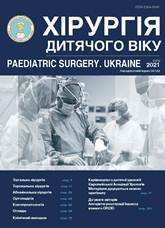Conservative (non-invasive) management of children with splenic cysts
DOI:
https://doi.org/10.15574/PS.2021.71.26Keywords:
spleen cyst, children, conservative, non-invasive, management, resultsAbstract
Surgeons’ views on tactics for treatment of splenic cysts (SC) in children are widely discussed in the literature. Indications and methods of conservative (non-invasive) management (observation) of children with SC is different issue.
Purpose – to develop rational tactical approache for conservative (non-invasive) management of children with SC.
Materials and methods. A retrospective analysis of conservative (non-invasive) management of 90 (33.96%) of 265 patients with SC was performed. Children were not operated if the SC was less than 20 mm (n=61) in diameter. They were first monitored by ultrasound 2 times for 6 months, then – 2 times a year, until puberty. We did not observe the progression of cyst growth in these children. Also did not operate children in whom the size of SC was from 20 to 62 mm, had an asymptomatic course and parents did not consent to surgical treatment (n=29). This is the most difficult group of patients to analyze, as most of them lack information about the dynamic observation. According to the results of dynamic observation in 19 of 29 examined patients’ regression of SC was not observed, which later served as an indication for surgical treatment.
Results and conclusions. In the presence of SC, a choice of surgical treatment or conservative (non-invasive) management is possible. Tactical approach for treatment of children with SC is strictly individual and depends on the size and location of the parenchymal lesion. In SC up to 20 mm diameter, conservative (non-invasive) management is rational, which is confirmed by the lack of progression of cyst growth in these children. Dynamic observation of patients with SC with a diameter of more than 20 mm without regression, serves as an indication for surgical treatment.
The research was carried out in accordance with the principles of the Helsinki declaration. The study protocol was approved by the Local Ethics Committee of an participating institution. The informed consent of the patient was obtained for conducting the studies.
No conflict of interest was declared by the authors.
References
Dan D, Bascombe N, Harnanan D, Hariharan S, Naraynsingh V. (2010). Laparoscopic management of a massive splenic cyst. Asian J Surg. 33 (2): 103-106. https://doi.org/10.1016/S1015-9584(10)60018-8
Delforge X, Chaussy Y, Borrego P, Abbo O, Sauvat F, Ballouhey Q, Irtan S, Arnaud A, Panait N, Rodesch G, Steyaert H, Schneider A, Dubois R, Mesureur S, Haraux E, Buisson P. (2017). Management of nonparasitic splenic cysts in children: A French multicenter review of 100 cases. J Pediatr Surg. 52 (9): 1465-1470. https://doi.org/10.1016/j.jpedsurg.2017.01.054; PMid:28185630
Di Serafno M, Verde F, Ferro F, Vezzali N. (2019). Ultrasonography of the pediatric spleen: a pictorial essay. Journal of Ultrasound. 22: 503-512. https://doi.org/10.1007/s40477-018-0341-2; PMid:30446947 PMCid:PMC6838283
Esposito S, Leonardi A, Penta L, Prestipino M, Bertozzi M. (2019). Giant epidermoid cyst of the spleen in a pediatric patient. A case report. Medicine. 98 (27): p.e15653. https://doi.org/10.1097/MD.0000000000015653; PMid:31277087 PMCid:PMC6635292
Garza-Serna U, Ovalle-Chao C, Martinez D, Flores-Villalba E, Diaz-Elizondo JA, Garza-Luna U de J. (2017). Laparoscopic partial splenectomy for congenital splenic cysts in a pediatric patient: case report and review of literature. Intern. J Surg Case. Rep. 33: 44-47. https://doi.org/10.1016/j.ijscr.2017.02.013; PMid:28267665 PMCid:PMC5338892
Gezer HO, Oğuzkurt P, Temiz A, İnce E et al. (2016). Spleen salvaging treatment approaches in non-parasitic splenic сysts in сhildhood. Indian J Surg. 78 (4): 293-298. https://doi.org/10.1007/s12262-015-1373-x; PMid:27574347 PMCid:PMC4987555
Hassoun J, Ortega G, Burkhalter LS, Josephs S, Qureshi FG. (2018). Management of nonparasitic splenic cysts in children. J Surg Research. 223: 142-148. https://doi.org/10.1016/j.jss.2017.09.036; PMid:29433866
Ingle SB, Hinge CR, Patrike S. (2014). Epithelial cysts of the spleen: A minireview. World J Gastroenterol. 20 (38): 13899-13903. https://doi.org/10.3748/wjg.v20.i38.13899; PMid:25320525 PMCid:PMC4194571
Kenney CD, Hoeger YE, Yetasook AK et al. (2014). Management of nonparasitic splenic cysts: does size really matter? J Gastrointest Surg. 18: 1658-1663. https://doi.org/10.1007/s11605-014-2545-x; PMid:24871081
Khan Z, Chetty R. (2016). A review of the cysts of the spleen. Diagnostic Histopathology. 22 (12): 479-484. https://doi.org/10.1016/j.mpdhp.2016.10.002
Sauvageot C, Faure J-M, Mousty E, Flandrin A, Forgues D, Prodhomme O, Fuchs F. (2018). Prenatal and postnatal evolution of isolated fetal splenic cysts. Prenat Diagn. 38 (6): 390-394. https://doi.org/10.1002/pd.5246; PMid:29528514
Sinha CK, Agrawal M. (2011). Nonparasitic splenic cysts in children: Current status. The Surgeon. 9: 49-53. https://doi.org/10.1016/j.surge.2010.08.005; PMid:21195332
Sinwar PD. (2014). Overwhelming post splenectomy infection syndrome - review study. Int J Surg. 12: 1314-1316. https://doi.org/10.1016/j.ijsu.2014.11.005; PMid:25463041
Tajik P, Goudarzian AH, Pourzahabi Z. (2019). Gastroenterol Hepatol Bed Bench. 12 (3): 260-262.
Tartar T, Bakal U, Sarac M, Kazez A. (2020). Laboratory results and clinical findings of children with hydatid cyst disease. 23 (7): 1008-1012. https://doi.org/10.4103/njcp.njcp_531_19; PMid:32620733
Downloads
Published
Issue
Section
License
The policy of the Journal “PAEDIATRIC SURGERY. UKRAINE” is compatible with the vast majority of funders' of open access and self-archiving policies. The journal provides immediate open access route being convinced that everyone – not only scientists - can benefit from research results, and publishes articles exclusively under open access distribution, with a Creative Commons Attribution-Noncommercial 4.0 international license(СС BY-NC).
Authors transfer the copyright to the Journal “PAEDIATRIC SURGERY.UKRAINE” when the manuscript is accepted for publication. Authors declare that this manuscript has not been published nor is under simultaneous consideration for publication elsewhere. After publication, the articles become freely available on-line to the public.
Readers have the right to use, distribute, and reproduce articles in any medium, provided the articles and the journal are properly cited.
The use of published materials for commercial purposes is strongly prohibited.

